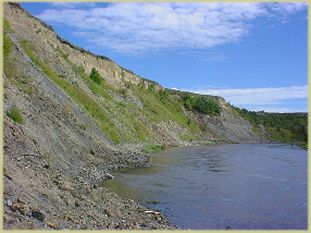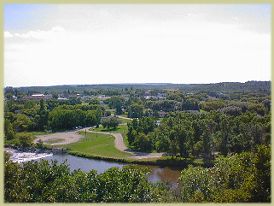 |
 |
||||||||||||||||||||||
|
South-western Manitoba and the immediate Wawanesa area was the scene of phenomenal geological changes many thousands of years before David Thompson's historic trek through our valley. During the Palaeozoic Era 550 to 220 million years ago, huge seas successively flooded into the continental interior of North America. During these inundations the limestone deposits later used in the construction of the legislative buildings, the oil deposits of Virden and Waskada, and the potash deposits of Russell were laid down. Geologists suggest that these seas were shallow accumulations of water that existed for ten thousand years, dried up and then flooded in again. During the Cenozoic Era 70 to I million years ago, the marine waters withdrew from Manitoba, leaving the province ready for the next incursion - that of the great ice sheet from the north. |
|||||||||||||||||||||||
 |
|||||||||||||||||||||||
|
|
|||||||||||||||||||||||
 |
During the Quaternary Period one million years ago to the present, at least four separate advances of ice scoured the Manitoba surface, and then retreated. Although the main land surface features such as the highlands and lowlands were formed before the Pleistocene or Ice Age, the mile thick ice sheets certainly played havoc with the surface deposits and drainage systems of Manitoba. As the last major glacier began its intermittent retreat northward, huge rivers flowed southeast along the foot of the glacier, drained glacial Lakes Agassiz and Souris, cut the majestic Pembina Valley, and carried the melt waters off to the Gulf of Mexico. |
||||||||||||||||||||||
|
|
|||||||||||||||||||||||
| As the ice receded the Assiniboine River found its present channel and the outlet of Lake Souris was diverted into it. The subsidence of the land due to the weight of the glaciers caused the Souris River to flow north in a raging torrent, thus cutting the Wawanesa gorge. The gorge is now a rugged length of valley lined on one side by sheer cliffs and trees that may have prompted an early wanderer to say, "Sipiweske," or "Light through the trees". |
|||||||||||||||||||||||
| In its early stages this subsequent tributary of the Assiniboine must have been a majestic river that carried millions of gallons of glacial water. This type of stream-rushing through our village site is difficult for us to visualize, but perhaps the spring flood of 1976 was some primeval flashback to its former power and glory. | |||||||||||||||||||||||
| Our present landscape reflects glacial and stream action. The flat to rolling farmland is referred to as lacustrine (lake-formed) plains. The huge glacial lakes laid down tons of alluvial material that are the foundation of some of the best agricultural land in Manitoba. The results of glaciation in our area are very evident as we view the moraines that are known as the Tiger and Brandon Hills. These sudden increases in elevation were formed when the glaciers on their retreat northward stagnated and dropped an extra load of glacial debris. As a twentieth century farmer works his fields, he is tilling the glacial materials while he views the scenic moraines in the distance. |
|||||||||||||||||||||||
 |
|||||||||||||||||||||||
|
|
|||||||||||||||||||||||
 |
|||||||||||||||||||||||
| But what has man seen of these changes to our landscape? The answer is that man has just recently come to the scene. Experts theorise that the first inhabitants of Manitoba lived in our area in the post glacial period, 12 thousand years ago, when south-western Manitoba was covered by boreal forest. These early people probably felt the same sense of exhilaration as David Thompson did in the 1700's, and as present inhabitants do when they catch their breath as they look out over the sheer cliffs that cradle Wawanesa. |
|||||||||||||||||||||||
|
|
|||||||||||||||||||||||
|
|
|||||||||||||||||||||||